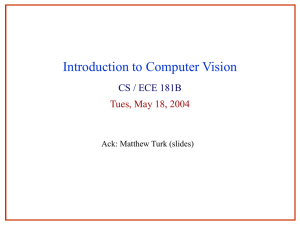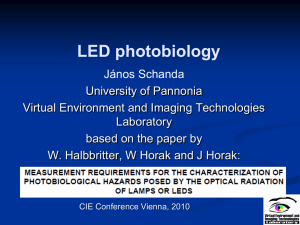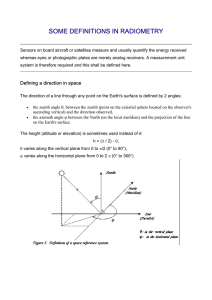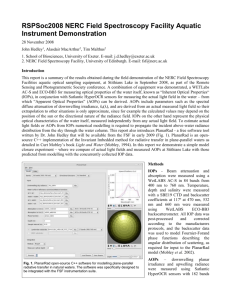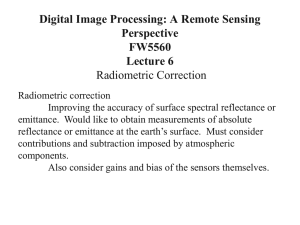docx
advertisement
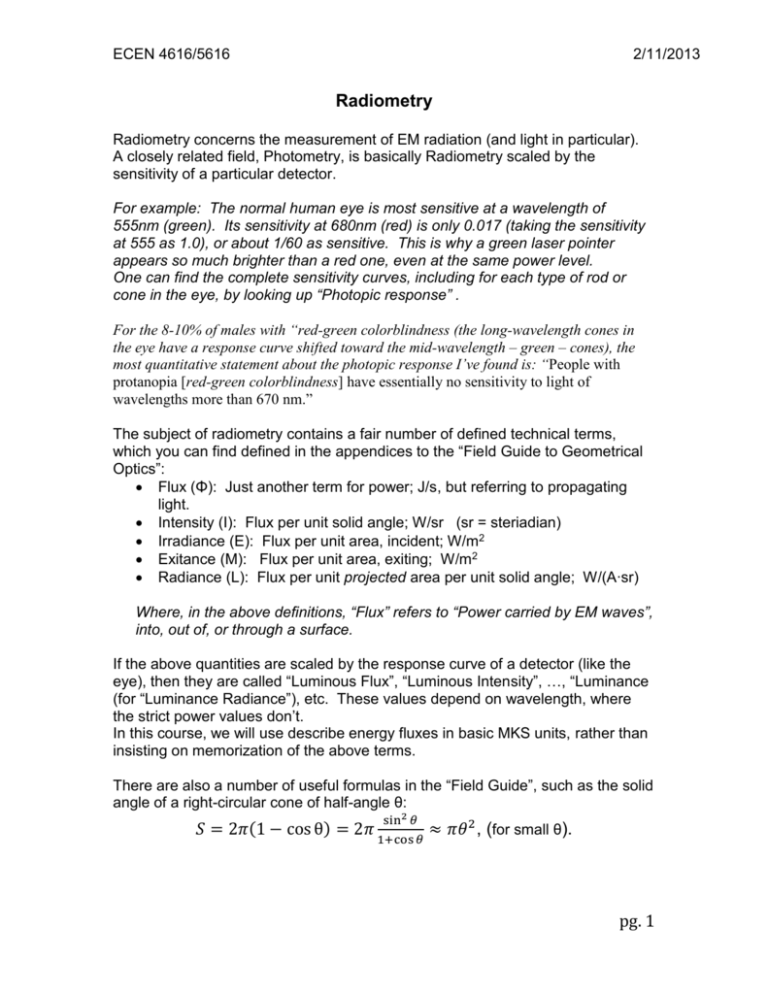
ECEN 4616/5616 2/11/2013 Radiometry Radiometry concerns the measurement of EM radiation (and light in particular). A closely related field, Photometry, is basically Radiometry scaled by the sensitivity of a particular detector. For example: The normal human eye is most sensitive at a wavelength of 555nm (green). Its sensitivity at 680nm (red) is only 0.017 (taking the sensitivity at 555 as 1.0), or about 1/60 as sensitive. This is why a green laser pointer appears so much brighter than a red one, even at the same power level. One can find the complete sensitivity curves, including for each type of rod or cone in the eye, by looking up “Photopic response” . For the 8-10% of males with “red-green colorblindness (the long-wavelength cones in the eye have a response curve shifted toward the mid-wavelength – green – cones), the most quantitative statement about the photopic response I’ve found is: “People with protanopia [red-green colorblindness] have essentially no sensitivity to light of wavelengths more than 670 nm.” The subject of radiometry contains a fair number of defined technical terms, which you can find defined in the appendices to the “Field Guide to Geometrical Optics”: Flux (Φ): Just another term for power; J/s, but referring to propagating light. Intensity (I): Flux per unit solid angle; W/sr (sr = steriadian) Irradiance (E): Flux per unit area, incident; W/m2 Exitance (M): Flux per unit area, exiting; W/m2 Radiance (L): Flux per unit projected area per unit solid angle; W/(A∙sr) Where, in the above definitions, “Flux” refers to “Power carried by EM waves”, into, out of, or through a surface. If the above quantities are scaled by the response curve of a detector (like the eye), then they are called “Luminous Flux”, “Luminous Intensity”, …, “Luminance (for “Luminance Radiance”), etc. These values depend on wavelength, where the strict power values don’t. In this course, we will use describe energy fluxes in basic MKS units, rather than insisting on memorization of the above terms. There are also a number of useful formulas in the “Field Guide”, such as the solid angle of a right-circular cone of half-angle θ: 𝑆 = 2𝜋(1 − cos θ) = 2𝜋 sin2 𝜃 1+cos 𝜃 ≈ 𝜋𝜃 2 , (for small θ). pg. 1 ECEN 4616/5616 2/11/2013 Lambertian Sources: (Why is the term “projected” in the definition of Radiance?) Lambert’s Law describes most diffuse, area sources of radiation. It says that the power emitted per area per steradian (i.e., the ‘radiance’) varies as the cosine of the angle between the radiation direction and the normal to the surface, as shown in the following figure: Does this make such a source become dim, as the angle of incidence increases? Consider a telescope looking at a fraction of the surface of such a lambertian source, and consider what happens when the angle of incidence changes: Entrance pupil Field of view of Telescope A Ω B θ The telescope is receiving radiation over a solid angle Ω from each point on the source. For convenience, take the telescope field of view (FOV) to be a square, with extent D at the source. (This could, perhaps, be the FOV of a single pixel in a detector.) Let us assume the source has a radiance of R w/(m2∙st). In the case labeled ‘A’ where the emitting surface is normal to the direction to the telescope, the total emitting area is D2 and the total received power is: 𝑃 = 𝑅𝐷2 𝛺 In the case labeled ‘B’, the source normal is at an angle θ to the axis and the effective radiance is R cos(θ) w/(m2∙st). However, the area of emitting surface seen in the FOV is now D2/cos(θ), so the total power received is: 𝑃 = 𝑅𝑐𝑜𝑠(𝜃) ∙ 𝐷2 cos(𝜃) ∙ 𝛺 = 𝑅𝐷2 𝛺, the same as before. This is why the Sun appears equally bright at the edge of its disk as at the center. pg. 2 ECEN 4616/5616 2/11/2013 Under what circumstances would a Lambertian source appear dimmer, when tilted? When the entire source falls within the FOV of a single detector – then the projected area decreases with tilt, and so does the total flux. A similar situation occurs when the source is not resolved – the geometric image is smaller than the Point Spread Function of the optics. Energy transmitted through an optical system: (A) h D Ω’ u I u’ Ω O h’ (A’) z z’ Assume the object, O, has an area, A (proportional to h2), and a radiance, L w/(m2∙sr). Therefore, the total power emitted into solid angle Ω is then P=L∙A∙Ω. Ignoring any transmission losses for the moment, the incident power, P, is transmitted to the image, which has an area A’ (proportional to (h’)2). Hence: 𝐿𝐴𝛺 = 𝐿′ 𝐴′ 𝛺 ′ Using the small angle approximation, Ω=πu2 and Ω’=π(u’)2. Also, A is proportional to h2 and A’ is proportional to (h’)2. ℎ′ 𝑢 Consider the magnification, m: 𝑚 = ℎ = 𝑢′ = (notes, 1/30/13), and similar triangles. From this it follows that 𝑚2 = 𝐴′ 𝐴 𝛺 𝑧′ 𝑧 from the Optical Invariant 𝛺 = 𝛺′ and 𝐴′ = 𝑚2 𝐴, 𝛺 ′ = 𝑚2 . Therefore 𝐴′ 𝛺 ′ = 𝐴𝛺, and we can conclude that 𝐿′ = 𝐿; that the radiance of the image (inside the solid angle Ω’) is the same as the radiance of the object, ignoring transmission losses. pg. 3 ECEN 4616/5616 2/11/2013 Exposure: The exposure is defined as the energy deposited on the detector per unit area; therefore the exposure is the irradiance of the image (in w/m 2) times the exposure time in seconds. The irradiance of the image is simply the radiance (𝑤⁄(𝑚2 ∙ 𝑠𝑟)) times the solid angle, Ω’, over which the radiance exists: 𝐸 ′ = 𝐿 ∙ 𝛺 ′ . We will make some simplifying assumptions to achieve a concise result (the more complete expression can always be derived as needed from the above): For most uses of cameras, the distance to the object, z, is much greater than the focal length of the camera lens. Hence, z’≈ f, the focal length of the lens. We will also assume that the focal length, f, is significantly greater than D, the diameter 𝐷 1 1 2 𝑓 of the aperture. Hence 𝑢′ ≅ 2𝑓 = 2∙𝐹# , and 𝛺 ′ ≅ 𝜋 (2∙𝐹#) , where 𝐹# ≡ 𝐷 . The irradiance (w/m2) of the image is: 𝐸′ = 𝜋 𝐿 𝑤 ( 2) 2 4 (𝐹#) 𝑚 . This is known as the “camera equation”, and shows how to set exposures for objects of given brightness (radiance), L: For an exposure of T seconds, the energy deposited on the detector is E’T Joules/meter2. An interesting feature of this relation is that the proper exposure for an object of a given radiance (brightness) is independent of the distance to that object. The correct exposure (for a given camera and detector) of the surface of the sunlit Moon, for example, is the same whether you are on the surface of the Moon, or taking the picture from Earth. That this is reasonable can be seen by considering the first figure: If you double the distance to the object (while the image distance remains nearly constant), you reduce the amount of power received by a factor of 4, but also reduce the image area by the same amount – hence maintaining the same irradiance (w/m2) at the image. The camera equation is derived from geometric optics, and no longer holds when the geometrical image of an object is significantly smaller than the real (diffraction) image, e.g., the point spread function. pg. 4



